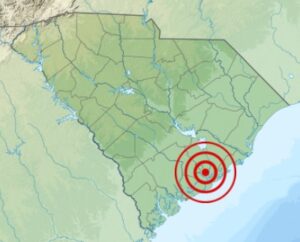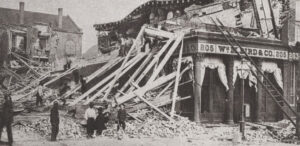
 The shaking began at 9:51pm that August 31, 1886, and by the time it was over, more than 100 people in Charleston, South Carolina would be dead and hundreds of buildings were destroyed. It wasn’t that there were no warnings. There were…unheeded warnings in the form of two foreshocks that were felt in Summerville, South Carolina, on August 27th and 28th, but no one was prepared for the strength of the August 31 quake. The quake was felt as far away as Boston, Chicago, and even Cuba. Buildings were damaged as far away as Ohio and Alabama.
The shaking began at 9:51pm that August 31, 1886, and by the time it was over, more than 100 people in Charleston, South Carolina would be dead and hundreds of buildings were destroyed. It wasn’t that there were no warnings. There were…unheeded warnings in the form of two foreshocks that were felt in Summerville, South Carolina, on August 27th and 28th, but no one was prepared for the strength of the August 31 quake. The quake was felt as far away as Boston, Chicago, and even Cuba. Buildings were damaged as far away as Ohio and Alabama.
Even with all that, it was Charleston, South Carolina that took the biggest hit from the quake. While quake measurements in those days were not as accurate as they are these days, this quake was thought to measure a magnitude of about 7.6. Almost all of the buildings in Charleston were seriously damaged. Approximately 14,000 chimneys fell from the earthquake. Multiple fires erupted, and water lines and wells were ruptured. The total damage was in excess of $5.5 million in those days, which would figure to approximately $115 million today. The greatest damage was done to buildings constructed out of brick, which amounted to 81% of building damage. The frame buildings suffered significantly less damage. Another factor that came into play was kind of  ground these buildings were built on. Buildings constructed on ground that had been built up to accommodate them (made ground), suffered significantly more damage than buildings constructed on solid ground, however, this relationship only occurred in wood-frame buildings. Approximately 14% of wood-frame buildings built on “made ground” sustaining damage, compared to 0.5% of wood-frame buildings built on solid ground sustaining damage.
ground these buildings were built on. Buildings constructed on ground that had been built up to accommodate them (made ground), suffered significantly more damage than buildings constructed on solid ground, however, this relationship only occurred in wood-frame buildings. Approximately 14% of wood-frame buildings built on “made ground” sustaining damage, compared to 0.5% of wood-frame buildings built on solid ground sustaining damage.
The residential buildings sustained significantly less damage than the more prominent commercial buildings, most of which were destroyed, or nearly so. This was due to the fact that commercial buildings were older, had a more prominent top compared to the base of the building, and were made of brick. The Old White Meeting House near Summerville, South Carolina was reduced to ruins. Many of the other man-made structures were also damaged as a result of earth splits caused by the earthquake. The railroad tracks in Charleston and nearby areas were snapped and trains were derailed. In addition, flooding occurred in surrounding farms and roads when dams broke. Acres of land actually liquefied in many spots, which further damaged many buildings, roads, bridges, and farm fields.
Strangely, for an earthquake of this magnitude anyway, was the fact that there were no apparent surface cracks as a result of this tremor, but railroad tracks were bent in all directions in some locations. The true cause of this quake remained a mystery for many years, because there were no known underground faults for 60 
 miles in any direction. However, now, with better science and detection methods, scientists have recently uncovered a “concealed fault” along the coastal plains of Virginia and the Carolinas. While there is now a known fault, a quake of this magnitude is highly unlikely in this location. Nevertheless, this was the largest recorded earthquake in the history of the southeastern United States.
miles in any direction. However, now, with better science and detection methods, scientists have recently uncovered a “concealed fault” along the coastal plains of Virginia and the Carolinas. While there is now a known fault, a quake of this magnitude is highly unlikely in this location. Nevertheless, this was the largest recorded earthquake in the history of the southeastern United States.


Leave a Reply